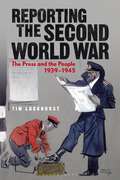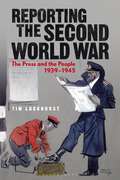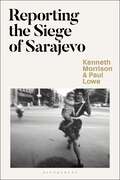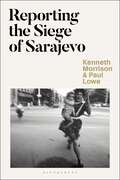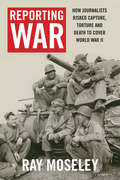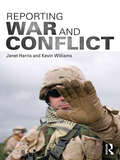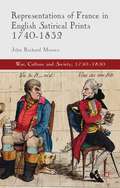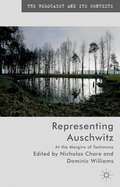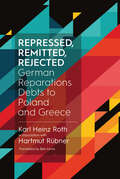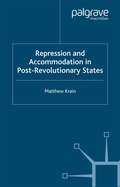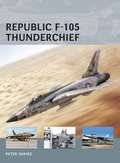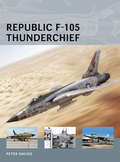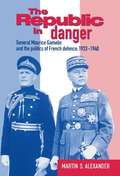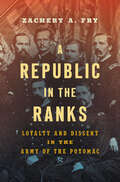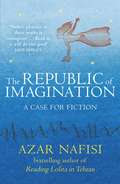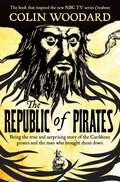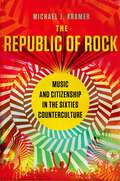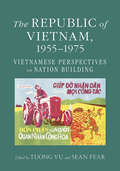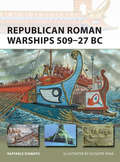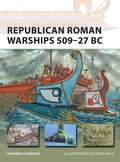- Table View
- List View
Reporting the Second World War: The Press and the People 1939-1945
by Tim LuckhurstThe decisive role of Britain's wartime newspaper journalism in shaping public opinion and government policy has been majorly overlooked. Much of the existing historiography has framed Britain's newspapers as mouthpieces of state propaganda, readily conforming to the wishes of the wartime coalition. Tim Luckhurst challenges this through an analysis of illuminating and largely forgotten controversies which underscore the function the press held as guardians of democracy and propagators of dissenting opinion in British politics and society - from the overseas evacuation of children to the Allies' carpet bombing of German cities.Reporting the Second World War is a timely and important intervention that duly recognises the place of national, regional and specialist titles in speaking truth to power in a democracy at war.
Reporting the Second World War: The Press and the People 1939-1945
by Tim LuckhurstThe decisive role of Britain's wartime newspaper journalism in shaping public opinion and government policy has been majorly overlooked. Much of the existing historiography has framed Britain's newspapers as mouthpieces of state propaganda, readily conforming to the wishes of the wartime coalition. Tim Luckhurst challenges this through an analysis of illuminating and largely forgotten controversies which underscore the function the press held as guardians of democracy and propagators of dissenting opinion in British politics and society - from the overseas evacuation of children to the Allies' carpet bombing of German cities.Reporting the Second World War is a timely and important intervention that duly recognises the place of national, regional and specialist titles in speaking truth to power in a democracy at war.
Reporting the Siege of Sarajevo
by Kenneth Morrison Paul LoweThe Siege of Sarajevo remains the longest siege in modern European history, lasting three times longer than the Battle of Stalingrad and over a year longer than the Siege of Leningrad. Reporting the Siege of Sarajevo provides the first detailed account of the reporting of this siege and the role that journalists played in highlighting both military and non-military aspects of it. The book draws on detailed primary and secondary material in English and Bosnian, as well as extensive interviews with international correspondents who covered events in Sarajevo from within siege lines. It also includes hitherto unpublished images taken by the co-author and award-winning photojournalist, Paul Lowe.Together Morrison and Lowe document a relatively short but crucial period in both the history of Bosnia & Herzegovina, the city of Sarajevo and the profession of journalism. The book provides crucial observations and insights into an under-researched aspect of a critical period in Europe's recent history.
Reporting the Siege of Sarajevo
by Kenneth Morrison Paul LoweThe Siege of Sarajevo remains the longest siege in modern European history, lasting three times longer than the Battle of Stalingrad and over a year longer than the Siege of Leningrad. Reporting the Siege of Sarajevo provides the first detailed account of the reporting of this siege and the role that journalists played in highlighting both military and non-military aspects of it. The book draws on detailed primary and secondary material in English and Bosnian, as well as extensive interviews with international correspondents who covered events in Sarajevo from within siege lines. It also includes hitherto unpublished images taken by the co-author and award-winning photojournalist, Paul Lowe.Together Morrison and Lowe document a relatively short but crucial period in both the history of Bosnia & Herzegovina, the city of Sarajevo and the profession of journalism. The book provides crucial observations and insights into an under-researched aspect of a critical period in Europe's recent history.
Reporting War: How Foreign Correspondents Risked Capture, Torture and Death to Cover World War II
by Ray MoseleyLuminary journalists Ed Murrow, Martha Gellhorn, Walter Cronkite, and Clare Hollingworth were among the young reporters who chronicled World War II’s daily horrors and triumphs for Western readers. In this fascinating book, Ray Moseley, himself a former foreign correspondent who encountered a number of these journalists in the course of his long career, mines the correspondents’ writings to relate, in an exhilarating parallel narrative, the events across every theater—Europe, Pearl Harbor, North Africa, and Japan—as well as the lives of the courageous journalists who doggedly followed the action and the story, often while embedded in the Allied armies. Moseley’s broad and intimate history draws on newly unearthed material to offer a comprehensive account both of the war and the abundance of individual stories and overlooked experiences, including those of women and African-American journalists, which capture the drama as it was lived by reporters on the front lines of history.
Reporting War and Conflict
by Kevin Williams Janet HarrisReporting War and Conflict brings together history, theory and practice to explore the issues and obstacles involved in the reporting of contemporary war and conflict. The book examines the radical changes taking place in the working practices and day-today routines of war journalists, arguing that managing risk has become central to modern war correspondence. How individual reporters and news organisations organise their coverage of war and conflict is increasingly shaped by a variety of personal, professional and institutional risks. The book provides an historical and theoretical context to risk culture and the work of war correspondents, paying particular attention to the changing nature of technology, organisational structures and the role of witnessing. The conflicts in Iraq, Afghanistan and Syria are examined to highlight how risk and the calculations of risk vary according to the type of conflict. The focus is on the relationship between propaganda, censorship, the sourcing of information and the challenges of reporting war in the digital world. The authors then move on to discuss the arguments around risk in relation to gender and war reporting and the coverage of death on the battlefield. Reporting War and Conflict is a guide to the contemporary changes in warfare and the media environment that have influenced war reporting. It offers students and researchers in journalism and media studies an invaluable overview of the life of a modern war correspondent.
Reporting War and Conflict (PDF)
by Kevin Williams Janet HarrisReporting War and Conflict brings together history, theory and practice to explore the issues and obstacles involved in the reporting of contemporary war and conflict. The book examines the radical changes taking place in the working practices and day-today routines of war journalists, arguing that managing risk has become central to modern war correspondence. How individual reporters and news organisations organise their coverage of war and conflict is increasingly shaped by a variety of personal, professional and institutional risks. The book provides an historical and theoretical context to risk culture and the work of war correspondents, paying particular attention to the changing nature of technology, organisational structures and the role of witnessing. The conflicts in Iraq, Afghanistan and Syria are examined to highlight how risk and the calculations of risk vary according to the type of conflict. The focus is on the relationship between propaganda, censorship, the sourcing of information and the challenges of reporting war in the digital world. The authors then move on to discuss the arguments around risk in relation to gender and war reporting and the coverage of death on the battlefield. Reporting War and Conflict is a guide to the contemporary changes in warfare and the media environment that have influenced war reporting. It offers students and researchers in journalism and media studies an invaluable overview of the life of a modern war correspondent.
Representations of Anne Frank in American Literature: Stories in New Ways (Routledge Interdisciplinary Perspectives on Literature)
by Rachael McLennanThis book explores portrayals of Anne Frank in American literature, where she is often invoked, if problematically, as a means of encouraging readers to think widely about persecution, genocide, and victimisation; often in relation to gender, ethnicity, and race. It shows how literary representations of Anne Frank in America over the past 50 years reflect the continued dominance of the American dramatic adaptations of Frank’s Diary in the 1950s, and argues that authors feel compelled to engage with the problematic elements of these adaptations and their iconic power. At the same time, though, literary representations of Frank are associated with the adaptations; critics often assume that these texts unquestioningly perpetuate the problems with the adaptations. This is not true. This book examines how American authors represent Frank in order to negotiate difficult questions relating to representation of the Holocaust in America, and in order to consider gender, coming of age, and forms of inequality in American culture in various historical moments; and of course, to consider the ways Frank herself is represented in America. This book argues that the most compelling representations of Frank in American literature are alert to their own limitations, and may caution against making Frank a universal symbol of goodness or setting up too easy identifications with her. It will be of great interest to researchers and students of Frank, the Holocaust in American fiction and culture, gender studies, life writing, young adult fiction, and ethics.
Representations of Anne Frank in American Literature: Stories in New Ways (Routledge Interdisciplinary Perspectives on Literature)
by Rachael McLennanThis book explores portrayals of Anne Frank in American literature, where she is often invoked, if problematically, as a means of encouraging readers to think widely about persecution, genocide, and victimisation; often in relation to gender, ethnicity, and race. It shows how literary representations of Anne Frank in America over the past 50 years reflect the continued dominance of the American dramatic adaptations of Frank’s Diary in the 1950s, and argues that authors feel compelled to engage with the problematic elements of these adaptations and their iconic power. At the same time, though, literary representations of Frank are associated with the adaptations; critics often assume that these texts unquestioningly perpetuate the problems with the adaptations. This is not true. This book examines how American authors represent Frank in order to negotiate difficult questions relating to representation of the Holocaust in America, and in order to consider gender, coming of age, and forms of inequality in American culture in various historical moments; and of course, to consider the ways Frank herself is represented in America. This book argues that the most compelling representations of Frank in American literature are alert to their own limitations, and may caution against making Frank a universal symbol of goodness or setting up too easy identifications with her. It will be of great interest to researchers and students of Frank, the Holocaust in American fiction and culture, gender studies, life writing, young adult fiction, and ethics.
Representations of France in English Satirical Prints 1740-1832 (War, Culture and Society, 1750-1850)
by J. MooresBetween 1740 and 1832, England witnessed what has been called its 'golden age of caricature', coinciding with intense rivalry and with war with France. This book shows how Georgian satirical prints reveal attitudes towards the French 'Other' that were far more complex, ambivalent, empathetic and multifaceted than has previously been recognised.
Representing Auschwitz: At the Margins of Testimony (The Holocaust and its Contexts)
by Nicholas Chare and Dominic WilliamsThis collection of essays by leading international scholars takes the Scrolls of Auschwitz as its starting point. These powerful hand-written testimonies, produced within Birkenau, seek to bear witness to mass murder from at its core. The highly literary accounts pose a fundamental challenge to the idea the Holocaust cannot be attested to.
Repressed, Remitted, Rejected: German Reparations Debts to Poland and Greece
by Dr Karl Heinz Roth Hartmut RübnerSince unification, the Federal Republic of Germany has made vaunted efforts to make amends for the crimes of the Third Reich. Yet it remains the case that the demands for restitution by many countries that were occupied during the Second World War are unresolved, and recent demands from Greece and Poland have only reignited old debates. This book reconstructs the German occupation of Poland and Greece and gives a thorough accounting of these debates. Working from the perspective of international law, it deepens the scholarly discourse around the issue, clarifying the ‘never-ending story’ of German reparations policy and making a principled call for further action. A compilation of primary sources comprising 125 annotated key texts (512 pages) on the complexity of reparations discussions covering the period between 1941 and the end of 2017 is available for free on the Berghahn Books website, doi: 10.3167/9781800732575.dd.
Repressed, Remitted, Rejected: German Reparations Debts to Poland and Greece
by Dr Karl Heinz Roth Hartmut RübnerSince unification, the Federal Republic of Germany has made vaunted efforts to make amends for the crimes of the Third Reich. Yet it remains the case that the demands for restitution by many countries that were occupied during the Second World War are unresolved, and recent demands from Greece and Poland have only reignited old debates. This book reconstructs the German occupation of Poland and Greece and gives a thorough accounting of these debates. Working from the perspective of international law, it deepens the scholarly discourse around the issue, clarifying the ‘never-ending story’ of German reparations policy and making a principled call for further action. A compilation of primary sources comprising 125 annotated key texts (512 pages) on the complexity of reparations discussions covering the period between 1941 and the end of 2017 is available for free on the Berghahn Books website, doi: 10.3167/9781800732575.dd.
Repression and Accommodation in Post-Revolutionary States
by M. KrainWe know very little about political dynamics in states that have just experienced an internal war, despite the increasing need to deal with such states in the post-Cold War world. Matthew Krain examines what prompts leaders in post-revolutionary states to employ repression or accommodation. Through statistical analysis and case studies of Iran, Cuba, Nicaragua, and Bolivia, he also examines the effects of these choices on how the domestic opposition reacts, what type of political system develops in the new state, and whether or not the leaders who institute these policies survive in power in the long run. Krain concludes with a series of policy recommendations.
Republic F-105 Thunderchief (Air Vanguard #2)
by Peter E. Davies Adam Tooby Henry MorsheadThe Republic F-105 Thunderchief was the fastest and most successful strike fighter of the Cold War. Designed to deliver nuclear weapons at low altitude and then fight its way back to base, by the early 1960s it was the primary weapon in the USAF's tactical strike arsenal. Thunderchief pilots in Europe, the Far East and the USA stood on short-notice alert, ready to take on the formidable defenses of their Communist Bloc targets. The F-105 was, however, to become a legend in a very different conflict. As direct American involvement in Vietnam increased, F-105s were deployed – initially as a deterrent, but ever more as conventional attack fighters against insurgency in Laos and Vietnam. With the start of the bombing campaign against North Vietnam, the Thunderchief became a vital element in attacks against some of the most heavily defended territory in modern history.
Republic F-105 Thunderchief (Air Vanguard #2)
by Peter E. Davies Adam Tooby Mr Henry MorsheadThe Republic F-105 Thunderchief was the fastest and most successful strike fighter of the Cold War. Designed to deliver nuclear weapons at low altitude and then fight its way back to base, by the early 1960s it was the primary weapon in the USAF's tactical strike arsenal. Thunderchief pilots in Europe, the Far East and the USA stood on short-notice alert, ready to take on the formidable defenses of their Communist Bloc targets. The F-105 was, however, to become a legend in a very different conflict. As direct American involvement in Vietnam increased, F-105s were deployed – initially as a deterrent, but ever more as conventional attack fighters against insurgency in Laos and Vietnam. With the start of the bombing campaign against North Vietnam, the Thunderchief became a vital element in attacks against some of the most heavily defended territory in modern history.
The Republic in Danger: General Maurice Gamelin and the Politics of French Defence, 1933–1940 (PDF)
by Martin S. AlexanderThis is the first full-length study in English of the career of one of France's most controversial military leaders, General Maurice Gamelin (1872–1958). Gamelin was reviled by many of his contemporaries and denigrated by historians as 'the man who lost the Battle of France'. Here Gamelin is re-appraised in the context of the unstable civil-military relations and national decline of the years 1933–40.
A Republic in the Ranks: Loyalty and Dissent in the Army of the Potomac (Civil War America)
by Zachery A. FryThe Army of the Potomac was a hotbed of political activity during the Civil War. As a source of dissent widely understood as a frustration for Abraham Lincoln, its onetime commander, George B. McClellan, even secured the Democratic nomination for president in 1864. But in this comprehensive reassessment of the army's politics, Zachery A. Fry argues that the war was an intense political education for its common soldiers. Fry examines several key crisis points to show how enlisted men developed political awareness that went beyond personal loyalties. By studying the struggle between Republicans and Democrats for political allegiance among the army's rank and file, Fry reveals how captains, majors, and colonels spurred a pro-Republican political awakening among the enlisted men, culminating in the army's resounding Republican voice in state and national elections in 1864.For decades, historians have been content to view the Army of the Potomac primarily through the prism of its general officer corps, portraying it as an arm of the Democratic Party loyal to McClellan's leadership and legacy. Fry, in contrast, shifts the story's emphasis to resurrect the successful efforts of proadministration junior officers who educated their men on the war's political dynamics and laid the groundwork for Lincoln's victory in 1864.
The Republic of Imagination: America In Three Books
by Azar NafisiFrom the author of the bestselling memoir Reading Lolita in Tehran comes a powerful and passionate case for the vital role of fiction today.Ten years ago, Azar Nafisi electrified readers with her million-copy bestseller, Reading Lolita in Tehran, which told the story of how, against the backdrop of morality squads and executions, she taught The Great Gatsby and other classics to her eager students in Iran. In this exhilarating follow-up, Nafisi has written the book her fans have been waiting for: an impassioned, beguiling and utterly original tribute to the vital importance of fiction in a democratic society. Taking her cue from a challenge thrown to her at a reading, she energetically responds to those who say fiction has nothing to teach us today. Blending memoir and polemic with close readings of her favourite novels, she invites us to join her as citizens of her 'Republic of Imagination', a country where the villains are conformity, and orthodoxy and the only passport to entry is a free mind and a willingness to dream.
The Republic of Pirates: Being the true and surprising story of the Caribbean pirates and the man who brought them down
by Colin WoodardFor fans of Black Sails and Crossbones comes a new history of the Golden Age of Piracy. . . In the early eighteenth century a number of the great pirate captains, including Edward 'Blackbeard' Teach and 'Black Sam' Bellamy, joined forces. This infamous 'Flying Gang' was more than simply a thieving band of brothers. Many of its members had come to piracy as a revolt against conditions in the merchant fleet and in the cities and plantations in the Old and New Worlds. Inspired by notions of self-government, they established a crude but distinctive form of democracy in the Bahamas, carving out their own zone of freedom in which indentured servants were released and leaders chosen or deposed by a vote. They were ultimately overcome by their archnemesis, Captain Woodes Rogers-a merchant fleet owner and former privateer - and the brief but glorious Republic of Pirates came to an end.Meticulously researched and full of incident and adventure, The Republic of Pirates brings to life an extraordinary forgotten chapter of history.
The Republic of Rock: Music and Citizenship in the Sixties Counterculture
by Michael J. KramerIn his 1967 megahit "San Francisco," Scott McKenzie sang of "people in motion" coming from all across the country to San Francisco, the white-hot center of rock music and anti-war protests. At the same time, another large group of young Americans was also in motion, less eagerly, heading for the jungles of Vietnam. Now, in The Republic of Rock, Michael Kramer draws on new archival sources and interviews to explore sixties music and politics through the lens of these two generation-changing places--San Francisco and Vietnam. From the Acid Tests of Ken Kesey and the Merry Pranksters to hippie disc jockeys on strike, the military's use of rock music to "boost morale" in Vietnam, and the forgotten tale of a South Vietnamese rock band, The Republic of Rock shows how the musical connections between the City of the Summer of Love and war-torn Southeast Asia were crucial to the making of the sixties counterculture. The book also illustrates how and why the legacy of rock music in the sixties continues to matter to the meaning of citizenship in a global society today. Going beyond clichéd narratives about sixties music, Kramer argues that rock became a way for participants in the counterculture to think about what it meant to be an American citizen, a world citizen, a citizen-consumer, or a citizen-soldier. The music became a resource for grappling with the nature of democracy in larger systems of American power both domestically and globally. For anyone interested in the 1960s, popular music, and American culture and counterculture, The Republic of Rock offers new insight into the many ways rock music has shaped our ideas of individual freedom and collective belonging.
The Republic of Rock: Music and Citizenship in the Sixties Counterculture
by Michael J. KramerIn his 1967 megahit "San Francisco," Scott McKenzie sang of "people in motion" coming from all across the country to San Francisco, the white-hot center of rock music and anti-war protests. At the same time, another large group of young Americans was also in motion, less eagerly, heading for the jungles of Vietnam. Now, in The Republic of Rock, Michael Kramer draws on new archival sources and interviews to explore sixties music and politics through the lens of these two generation-changing places--San Francisco and Vietnam. From the Acid Tests of Ken Kesey and the Merry Pranksters to hippie disc jockeys on strike, the military's use of rock music to "boost morale" in Vietnam, and the forgotten tale of a South Vietnamese rock band, The Republic of Rock shows how the musical connections between the City of the Summer of Love and war-torn Southeast Asia were crucial to the making of the sixties counterculture. The book also illustrates how and why the legacy of rock music in the sixties continues to matter to the meaning of citizenship in a global society today. Going beyond clichéd narratives about sixties music, Kramer argues that rock became a way for participants in the counterculture to think about what it meant to be an American citizen, a world citizen, a citizen-consumer, or a citizen-soldier. The music became a resource for grappling with the nature of democracy in larger systems of American power both domestically and globally. For anyone interested in the 1960s, popular music, and American culture and counterculture, The Republic of Rock offers new insight into the many ways rock music has shaped our ideas of individual freedom and collective belonging.
The Republic of Vietnam, 1955–1975: Vietnamese Perspectives on Nation Building
Through the voices of senior officials, teachers, soldiers, journalists, and artists, The Republic of Vietnam, 1955–1975, presents us with an interpretation of "South Vietnam" as a passionately imagined nation in the minds of ordinary Vietnamese, rather than merely as an expeditious political construct of the United States government.The moving and honest memoirs collected, translated, and edited here by Tuong Vu and Sean Fear describe the experiences of war, politics, and everyday life for people from many walks of life during the fraught years of Vietnam's Second Republic, leading up to and encompassing what Americans generally call the "Vietnam War." The voices gift the reader a sense of the authors' experiences in the Republic and their ideas about the nation during that time. The light and careful editing hand of Vu and Fear reveals that far from a Cold War proxy struggle, the conflict in Vietnam featured a true ideological divide between the communist North and the non-communist South.
Republican Roman Warships 509–27 BC (New Vanguard)
by Giuseppe Rava Dr Raffaele D’AmatoThe birth of the mighty Roman Navy was anchored in the Romans' extraordinary ability to absorb and perfect the technology of other states and empires. This is the story of the design, development and operation of the Republican Roman warship in the age of the conquest of the Mediterranean, from the first Roman naval adventure of 394 BC and the Punic Wars, to Pompey's operations against the Cilician Pirates and Caesar's victorious naval campaigns in Armorica, concluding with the consolidation of the Mediterranean Sea as Mare Nostrum with the battle of Actium in 31 BC. Archaeological photography, including those of exciting new finds, such as the Roman warship rosta (rams) found in the Aegates Islands, accompany lavish artistic reconstructions in illustrating the ships of the first Roman navy.
Republican Roman Warships 509–27 BC (New Vanguard)
by Giuseppe Rava Raffaele D’AmatoThe birth of the mighty Roman Navy was anchored in the Romans' extraordinary ability to absorb and perfect the technology of other states and empires. This is the story of the design, development and operation of the Republican Roman warship in the age of the conquest of the Mediterranean, from the first Roman naval adventure of 394 BC and the Punic Wars, to Pompey's operations against the Cilician Pirates and Caesar's victorious naval campaigns in Armorica, concluding with the consolidation of the Mediterranean Sea as Mare Nostrum with the battle of Actium in 31 BC. Archaeological photography, including those of exciting new finds, such as the Roman warship rosta (rams) found in the Aegates Islands, accompany lavish artistic reconstructions in illustrating the ships of the first Roman navy.
